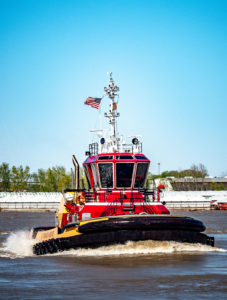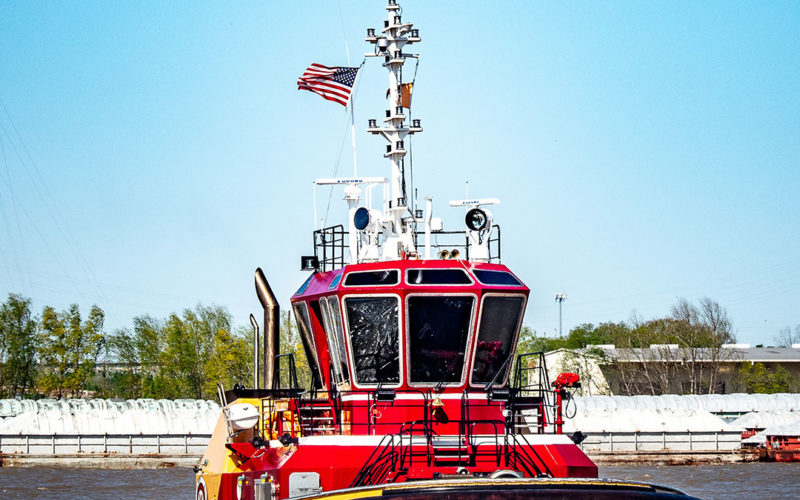
The 80-foot A. Thomas Higgins, named for a current owner of E.N. Bisso & Son, Inc., joined sister tug C.D. White in the company’s New Orleans fleet last year.
Both tugs, built at Eastern Shipbuilding in Panama City, Florida, are RApport 2400-series tugboats designed by Robert Allan, Ltd. of Vancouver, British Columbia. Both are outfitted and classified for ship assist and ocean transits.
“This boat was built to do jobs in very tight quarters,” Mike Killelea, E.N. Bisso’s port captain, said of A. Thomas Higgins. “It has great power for its size and the maneuverability is second to none.”
The new tugs are modified versions of Gladys B., acquired from Signet Shipbuilding and Repair of Pascagoula, Miss., in 2016. Gladys B. was the first Robert Allan-designed tug to work on the Mississippi River.
White and Higgins have proven their worth performing ship assist and escort duties along 230 miles of the Mississippi River, from Pilottown, near the river’s mouth, to Baton Rouge. They also perform ocean towing in the Gulf of Mexico.
“We’ve worked several jobs from Key West to Brownsville, Texas, and in ports, in all weather, in between,” said Luis Solano, a veteran of 32 years at E.N. Bisso, and captain of A. Thomas Higgins. “This boat is extremely stable in the Mississippi River, and the best handling boat on the river. She’s very agile.”
Although the three tugs share the same pedigree, there are some notable differences. For example, Gladys B. is powered with twin Tier 3 MTU mains. The two new tugs are fitted with Tier 4 Caterpillar 3512E engines.
“Our experience with the various Caterpillar 3512 and 3516 plants on our tugs showed that, for our purposes, the 3512Es were the right choice,” said Mike Vitt, an E.N. Bisso vice president. “Caterpillar engines also are more familiar to the crews and personnel operating and maintaining them.”
The 5,100-hp Caterpillar mains, supplied by Louisiana Cat, are shafted to Kongsberg US 205-P20 z-drives generating 67.5 tons of bollard pull and a top speed of 15.5 knots. Two 99-kW John Deere generators provide electrical power.
Jamie McCarthy, project manager for Robert Allan Ltd. said the skeg’s size was reduced on the new tugs. This gives them better maneuverability when handling ships in the strong currents on the Mississippi River year-round.
Another change was to move from raw-water cooling to keel cooling. “Gladys B. has raw-water heat exchanger cooling for the main machinery,” McCarthy said. “Although this works fine in the Gulf of Mexico, the Mississippi River tends to have a lot of debris, which can sometimes clog the strainers.” For the new tugs, the grid coolers are mounted in recesses in the hull.
The navigation light system, designed by JBOX of Harvey, La., is another difference. Killelea borrowed an innovation developed by Mike Nigro, a vice president with G&H Towing in Galveston, Texas.
The system allows for the navigation lights to be fully reversed by a single switch when the operator is towing in reverse.
If a ship under assist by the tug unexpectedly goes dark, the tug, having moved to an emergency tow mode, towing in reverse with the Markey Render/Recover hawser winch on the bow, will display the navigation lights correctly.
The fendering on Gladys B. was reworked to suit the new tug’s mission of assisting ships on the Mississippi River. McCarthy said they further improved the fendering to provide better side protection and stand-off from vessels.
Killelea, Steve Berthold, vice president of sales and marketing (now retired) at Eastern, and Dale Langley with Schuyler Cos., refined the fendering package on the new boats. “The improved fendering system allows the tugs to work where some vessels would encounter a metal-on-metal situation,” said Killelea.
Solano added that the fendering helps create a comfortable and forgiving ride offshore. “It is very quiet because there are no tires chained to the hull creating chain noise and chipping the paint.”
A 40-hp Markey Machinery DEPCF-42 HS single-drum electric hawser winch and a Smith Berger Marine bow staple with muscular side bitts dominate the foredeck. The winch is wound with 400 feet of Samson 2-5/8-inch Saturn-12 soft line.
On the Gladys B., the area required to fit the aft winch and H-bitt on the compact aft deck of the RApport 2400 series, utilized for barge towing on the hip, was not well suited to the new tug’s mission.
On the C.D. White and A. Thomas Higgins, a stern tow bitt, a Markey capstan and a 90-ton Washington Chain & Supply tow hook installed on the aft deck in a stacked configuration created a smaller machinery footprint. The setup maintained redundancy for towing and gear retrieval functions, with an optimal pivot point location.
There are three tow makeups available on the new boats. One is from the bow with the Markey hawser winch. Another employs the bow staple boasting 60 tons of bollard pull and the bitts rated for 150 tons of static bollard pull. Lastly, the vessel can tow off the stern engaging the tow hook, bitt and capstan.
To simplify the confusion caused by a host of alarms and monitors, First Electric Motor Service of Woburn, Mass., designed a Siemens modular-based alarm system. “The system interfaces with all the machinery in the engine room, the electrical switchboard, the battery bank monitoring, the bilges and also ultrasonically monitors all the tank levels,” said Killelea.
The captain and engineer can monitor all the tug’s functions on single monitors, mounted in the wheelhouse, engine room, galley, engineer’s stateroom and captain’s stateroom.
There are six fixed-mount CCTV cameras that monitor the engine room, the z-drive room and the forward and aft deck areas. A PTZ (pan, tilt, zoom) camera is mounted high on the mast and remotely operated from the wheelhouse. “This is an added measure of monitoring that the crew on board can utilize to respond more quickly to an event or emergency situation,” said Killelea.
Most tugboats are a second home for crew members, making comfort and amenities an important element in their design and construction. E.N. Bisso insisted on a high level of crew comfort on the boats, Killelea said. One priority was to build a quiet vessel to ensure crewmembers off watch can rest in order to prevent fatigue.
Noise reduction was achieved by fitting the machinery with vibration isolators, resilient mounts and exhaust spark arrester silencers. An insulation blanket of 3-inch thick fiberglass was applied to the inside of the exterior superstructure, pilot house bulkheads, exhaust stacks, under the decks and to the lower hull forward accommodation area.
“That sounds like enough,” said Killelea. “But we went one step further by insulating the joiner panels, thus resulting in the quietest vessel we have ever encountered. It takes some getting used to as the crew can barely hear the engines start and throttle up. On a tug, that’s almost unheard of.”
Attention was also paid to the operational access, functionality and ergonomics in the wheelhouse. The visibility is noteworthy, giving the operator a direct ship line and winch line of sight, and good peripheral and overhead visibility.
By the time specification discussions were underway with Eastern Shipbuilding, Killelea said he had already gathered a wish list from E.N Bisso’s captains, engineers and shoreside personnel.
“Almost all of which was approved and specified during the contract phase.”
The result is an obvious “Pride of Place” mentality exhibited by the crew and manifested by their dedication to keeping a copious amount of stainless steel, brass and brightwork gleaming aboard A. Thomas Higgins.

